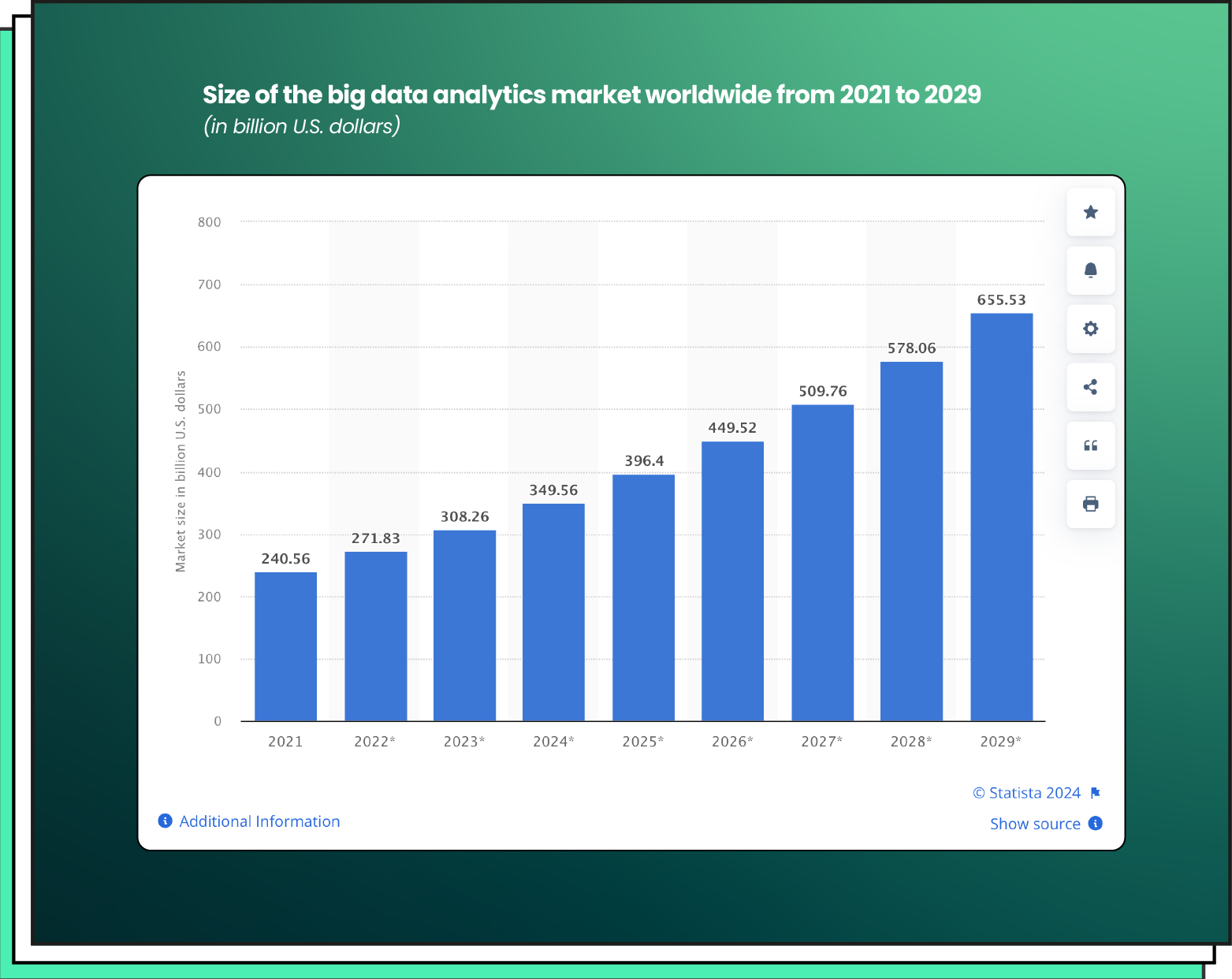Today, data is more than just facts and statistics collected for analysis. It is a vital instrument for businesses to understand their customers, sales, and revenues. You may think that the more information you have, the more data-driven decisions you will make, but it is not as simple as it sounds.
Data are increasing in size and complexity, making it challenging to focus only on essential aspects. So, data analysis can become an unfruitful and daunting task when relying solely on traditional BI tools. Notably, an American entrepreneur, Aaron Koblin, mentioned,
“I think you can have a ridiculously enormous and complex data set, but if you have the right tools and methodology, then it’s not a problem.”
The good news is that you can get the most out of data, capturing only relevant information and administering it correctly through data lifecycle management. This process is one of the most rational and convenient for processing data, streamlining its collection, storage, and utilization while generating more value for businesses.
In this article, I will reveal the key stages of data lifecycle management, its benefits, best practices, and security measures. As a data science company, at Forbytes, we are eager to share the knowledge about data management to take your business to the next level. So, keep reading.
What Is Data Lifecycle Management?
Data lifecycle management is an approach to data administration and storage. It aims to assist in handling data with maximum benefits for your company. This complex process involves data analytics, governance, scalability, performance, security, and storage. Additionally, data lifecycle management includes practices necessary for businesses to optimize their data handling methods.
So, data lifecycle management helps companies not get lost in tons of information but use it more efficiently and get the most out of their data. Moreover, it helps businesses find the data they need to get insights and make better decisions. That’s why I want to delve into the basic phases of data lifecycle management to ensure that your data are handled efficiently at each stage.
The Key Stages of Data Lifecycle Management
All data have a lifecycle composed of seven key stages. The role of data lifecycle management is to ensure that your data functions well at each step of that journey. Below are the standard phases of data lifecycle management.
Stage 1: Create and Collect
Companies can gather information either by creating data or obtaining existing ones from different sources. Therefore, it’s crucial to understand what data collection methods to apply. You may opt for quantitative techniques like the Internet of Things (IoT), IT systems, and enterprise software. But you may also choose qualitative methods like polls, surveys, and feedback forms. During this data lifecycle management phase, it’s also necessary to perform data cleaning if any unnecessary datasets are found.
Stage 2: Process and Classify
Processing data is the next stage of data lifecycle management, crucial for preparing them for in-depth analysis. Once data is created or collected, it’s necessary to understand how to organize and categorize it effectively. So, it’s recommended to structure and establish relations between different datasets to process them for further analysis. Then, it’s necessary to start with data classification to make it easier to find and refer to it later. For example, it’s possible to categorize data according to their value and sensitivity or how frequently they are accessed.
Stage 3: Store and Secure
Once data is processed, you need to store it somewhere. In this situation, you should consider the type of data. For instance, quantitative data are structured, allowing for relating and comparing to other relational datasets. So, as a rule, they are stored in a relational database system. A non-relational database is a good option for unstructured data which are not relational and text-heavy. Finally, it’s important to encrypt sensitive data to protect them from internal and external threats.
Step 4: Use and Analyze
After storing and securing data, it’s necessary to define who can access data and for what purposes. As a rule, data is transformed to become relevant and readable before being used. Plus, during this data lifecycle management stage, it’s crucial to analyze and visualize data to understand how they can be used for valuable insights and informed decision-making. Finally, applying AI data analytics or conventional data modeling is also recommended to speed up data analysis processes.
Step 5: Share and Distribute
Once data are analyzed, it’s necessary to find a storage for them and decide which data can be accessed and when. It’s recommended to be cautious with sensitive data and give access to them if this is justified. There are cases when there is a need to share data with external companies, especially for marketing purposes. In this case, data lifecycle management should ensure that internal policies allow data distribution among certain people.
Step 6: Archive and Record
If a company does not use certain data but may need them in the future, it’s necessary to archive them. This option retains a chance to access them later if needed. Data archives contribute to more efficient storage. What’s more, it’s also vital to ensure the accessibility of archived data without a need for restoration. Archived data should be stored in a separate space from operational data.
Step 7: Delete and Reuse
More is better, but this is not about data. Storing unnecessary data is a waste of resources which also exposes a company to additional risks. So, skipping the data destruction stage of data lifecycle management is not recommended. Once the time outlined in the data retention policy has passed, it’s necessary to delete them. But before starting the deletion process, it’s worth clarifying whether this data can be reused for other purposes.
So, see what a complex way your data should pass from creation to deletion. Now, it’s high time to reveal the goals of data lifecycle management and what benefits they can bring to your business.
Benefits of Data Lifecycle Management for Your Business
According to Statista, in 2023, the global big data analytics market was valued at over $225 billion, and it’s projected to reach over $650 billion by 2029.

Are you still doubting the value of big data for your business? I have more arguments for you to share. So, here’s the list of benefits you’ll get if you apply data lifecycle management:
Confidentiality for secure data use. Data lifecycle management guides on how to collect data legally and share them securely. This framework was developed with data protection policies at the core. So, having it, you’ll save personal and sensitive employee or customer data. Finally, you’ll position your business as responsible, ethical, and legally compliant.
Integrity for data accuracy and reliability. Data lifecycle management helps you maintain the integrity of your data by showing how to handle, use, and store your data. A lack of data integrity can lead you to wrong insights and conclusions. So, by relying upon data lifecycle management, you’ll use only accurate, precise, and reliable data for making major business decisions.
Availability for effective data processing. Data lifecycle management assists teams in accessing relevant data with minimal friction. By making data archiving more effective, data life cycle phases encourage businesses to save data in archives to use them later. Thus, data can be readily available for those who may need them.
Compliance with laws and regulations for responsible data handling. The value of data lifecycle management lies in its focus on responsible data handling and compliance with laws and regulations. This approach is perfect for companies who care about their reputation and safety and want to mitigate the threat of unauthorized access and data breaches.
Best Practices of Data Lifecycle Management
No doubt, if you follow all stages of data lifecycle management, you’ll use your data with maximum benefits for your business. But you should also consider the implementation of best practices to strengthen your reputation and mitigate other risks related to data handling. Here are some of them that I strongly recommend.
Data aggregation
Data aggregation is an important aspect of data lifecycle management, allowing us to see business data in a wider context. From collecting data from multiple sources to generating a summary – data aggregation gets everything covered. If we emphasize the parallel between data lifecycle management and data aggregation, it will become obvious that aggregated data are the products of various stages of the data lifecycle. Thus, they are intertwined as they both involve similar phases of data handling, as well as quality, security, and compliance.
Data standardization
Data standardization is crucial for preserving data quality throughout the data lifecycle management. It converts data into a standard format, allowing different systems to share and efficiently use data. Without data standardization, it’s challenging to communicate and exchange data, while with it, it is much easier to detect errors and ensure accuracy and reliability.
Developing a comprehensive data management plan
Another best practice contributing to data lifecycle management is building a clear plan for data handling. It should include approaches and techniques for data collecting, processing, storing, and disposing. What’s more, this plan should define roles responsible for managing data. Finally, a data management plan should involve conducting regular risk assessments to mitigate them on time.
Ensuring scalability and flexibility
Once you start with data lifecycle management, you should think about how to implement scalable infrastructure to handle growing volumes of data. If an infrastructure is scalable, data lifecycle management will work better and facilitate data exchange and integration. I also recommend ensuring the flexibility of the data management processes to make them adaptable to changing technologies and business needs.
Implementing data quality control
Maintaining the quality of your data is crucial for data lifecycle management, ensuring accuracy, convenient structure, and completeness. Quality control measures such as data standardization and validation assist in checking for errors and correcting them before the data is stored.
Data Security Measures
Data security is one of the essential aspects of data life cycle management that you cannot overlook, ensuring maximum data protection at every stage of its lifecycle. From access control and encryption to monitoring and controlling, these safety measures are used to restrict unauthorized access to data and detect possible threats. Thus, you can be sure that your data is protected through every phase of its management. Here is what I would suggest to keep your data protected.
Firstly, it is necessary to classify data based on data sensitivity and value to ensure the application of appropriate security measures. In this case, it’s crucial to identify which data requires the highest level of protection. Data classification is the most relevant at the data creation stage.
Secondly, I recommend implementing robust access control mechanisms to restrict access to sensitive data to grant permissions based on users’ roles. This safety measure is vital when storing and sharing data and when you should define who can access and use data.
Thirdly, it is significant to encrypt your data to safeguard it from unauthorized access. For example, such encryption algorithms as the Advanced Encryption Standard will be relevant to protect data from malicious actors. Data encryption should be performed while storing and archiving data.
Final Thoughts
It is safe to say that the future looks bright for data management, regardless of the tons of information that bombards us from all sides. No doubt, chances are zero that you can manage them manually. Thus, it is vital to follow all stages of data lifecycle management and apply the best practices to ensure data quality, security, and scalability.
And when you seek additional help, Forbytes is at your service. With our data management solutions, you can effortlessly handle the entire data lifecycle from one central location. We are interested in automating the process of data management, offering your reporting and analytics tools, and allowing you to extract only relevant data for valuable insights and strategic decisions. With our expertise in data science, you will fix the data mess, improving your data lifecycle management. We rely upon data management policies and regulations, ensuring compliance and security.
Ready to take control of your data lifecycle and protect your sensitive information? Contact us, and we will respond promptly to discuss how we can empower your business with quality data handling and robust data security strategies.








